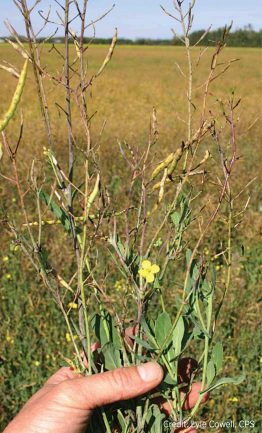Micronutrients: Take care of macros first
Key practice: Economic response to micronutrient applications is rare for canola in Western Canada. However, if growers apply recommended rates of nitrogen, phosphorus and sulphur and yields are not increasing, growers may want to check the micronutrient situation.
Key research: Karamanos, R.E., Westco Fertilizers, et al.
“Canola response to boron in Canadian prairie soils,” 2003,
Canadian Journal of Plant Science 83: 249–259
Of the six top micronutrients, boron is arguably the most important to canola on the Canadian Prairies. Whole plant tissue analysis of canola at flowering shows a sufficiency level of 29 parts per million for boron, compared to 19 ppm for iron, 14 for manganese, 14 for zinc, 2.6 for copper and 0.02 for molybdenum. What’s more, boron is one micronutrient deficiency most likely to show up in canola before it shows up in other crops.
Molybdenum is also more likely to show up in canola before any other crop, but molybdenum is needed at very low levels and deficiencies have not been observed in canola on the Prairies. Iron deficiency is also rare for any field crop on the Prairies. A deficiency in copper is more likely to show up in cereals before canola, manganese in oats before canola, and zinc in alfalfa, flax and beans before canola. Correcting any evident shortages in these other crops should take care of any potential deficiencies in canola.
For these reasons, boron tends to get more attention than any other micronutrient when it comes to canola nutrition management. However, documented cases of boron deficiency are rare.
When boron deficiencies are identified, they typically occur (although still rarely) in marginal sandy soils under dry conditions. These can be corrected with sodium borate broadcast and incorporated in the spring at rates of 0.5 to 1.5 lb./ac. or applied in crop at 0.3 to 0.5 lb./ac. It is worth noting here that rate selection and placement are important. Boron can be toxic to plants and over-application can decrease crop yield. Rates of sodium borate that exceed 1.0 lb./ac. in the seed row can kill canola seedlings.
Rigas Karamanos led a study, published as “Canola response to boron in Canadian prairie soils” in the Canadian Journal of Plant Science in 2003, that found no response to boron fertilizer — even on soils with less than 0.15 ppm hot-water extractable boron and with control canola yields of up to 63 bu./ac.
This builds on an earlier study by S.S. Malhi et al, called “Feasibility of boron fertilization on canola in the Saskatchewan parkland,” which they presented at the Soils and Crops Symposium in Saskatoon, SK, in 2000. Malhi’s study made the following valuable agronomic recommendation: “Some producers apply boron fertilizer to canola without knowing if boron application increases seed yield of canola. In order to save money and optimize the use of boron fertilizer, the following are suggestions to the canola producers: (a) Apply boron fertilizer in test strips and determine if there is any increase of seed yield, and then consider boron fertilization of whole fields on a regular basis. (b) If it is already planned to use boron fertilizer on canola, then leave some canola strips without boron fertilizer in the field and compare the seed yields with and without boron fertilizer.”

Source: Lyle Cowell, CPS
Boron for heat stress
Boron used to prevent bud blast and flower abortion due to heat stress has shown inconsistent results in Ontario field studies led by Hugh Earl at the University of Guelph. Earl has also done greenhouse trials showing a yield response when boron is applied to heat-stressed canola, but limited studies on the Prairies have not shown any consistent positive response to this practice.




